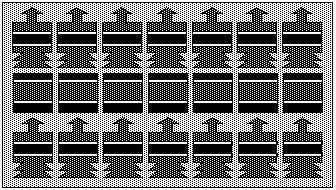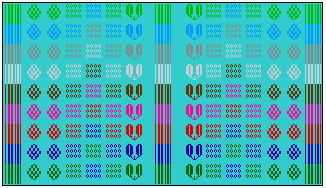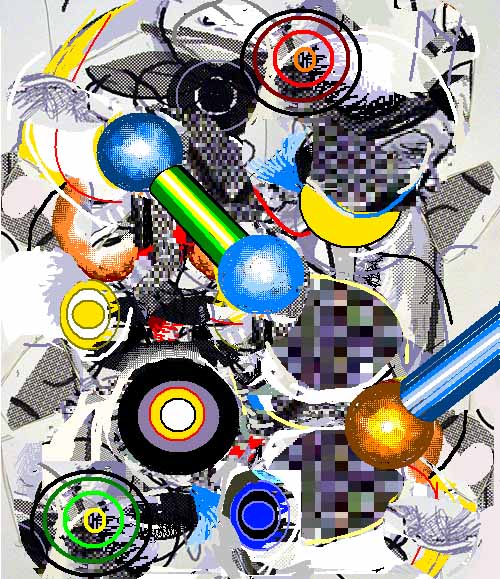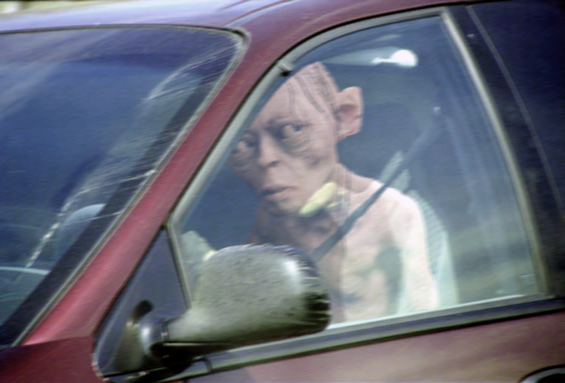View current page
...more recent posts


Via Travis Hallenbeck, African textiles using a programming language called Logo, specifically the GS LogoWriter on an Apple IIGS computer. The page linked to, a text written 12 years ago, goes into great technical detail as to how the patterns were created. I was not previously familiar with Logo or even that generation of Apples; it looks like another language-cum-family of gear (like Amiga, NES, etc) with a philosophy and a cult behind it. Obviously I'm spewing hot air here, being more interested in the beautiful finished product than how anyone arrived at it. But see What is Logo? if you're as un-up-to-speed as I am and want to know more.

"Robollywood" [4 MB .mp3]
"Darken Room, Eat Pills" [mp3 removed]
Both pieces use samples from NI's "simple waveform kit," hence the videogamy bleeps, as well as MIDI files intended for drum kits, run through synths as lead instruments. Fans of super-fast nerdy contrapuntal prog-rockish keyboard playing might like "Robollywood"--I'm constantly surprised how well percussion scores translate into tonal playing, with adult supervision in the form of splicing and muting notes.

artist unknown
My essay on painter Kara Hammond appears here, along with some images of her work (link at upper right), a couple of which were previously shown on this blog. The occasion for the writing is her show at the Halsey Gallery, College of Charleston, South Carolina, the school where she is now teaching.
Below are three views of Werner Herzog's great film Grizzly Man. All are interesting, though Ross Douthat's piece is a tad over-the top in its religious references. The writers should give Herzog more credit for the film's intellectual and emotional heft, though; if it makes sense to talk about religion at all it's because of the layer of profundity his commentary and editing bring to the found material, even though, pardon the further and possibly contradictory qualifier, his interest in intense, ecstatic states seems purely secular. Lindsay Beyerstein nails how the narcissism of doomed ursine documentarian Timothy Treadwell tainted his own mission, but Herzog sees magic in Treadwell's camera artistry, actor-like temperament, and willingness to go "out there" to the furthest edges of experience. David Edelstein notes Herzog's contributions but thinks they're melodramatic, and of course they are, it's Herzog, but their success in steering how we view Treadwell's footage is none the less awe-inspiring. Also in response to Berenstain, I mean, Beyerstein, Treadwell's knowledge of the bears isn't really "shallow"--he's constantly dropping factoids in the film about how they mate, fight, hibernate, kill their young... Maybe this information is wrong, but he clearly learned enough to live with them at close quarters for thirteen summers before they finally did him in.
Ross Douthat:
Grizzly Man is a film about religious experience, among many other things, but not a form of religious experience that's familiar to most people in the still-Christ-haunted West. Human beings are caught between the animal world and the spiritual world, bound by fleshly requirements, but able to imagine themselves as immortal, freed from bodily concerns, quasi-divine - and in response to this problem, Christianity (and most other mainstream faiths) tells people that the way out is up, and that to escape the conflicts and miseries that come with being half angel and half ape, you need to become more like an angel, and less like an ape.Lindsay Beyerstein:
But the imitatio Dei isn't the only possible solution to the dilemma of being made a little lower than the angels. You could also go in the other direction, and give up on human reason, human self-awareness, in the hopes of returning to a pre-rational, pre-spiritual, entirely animal state. This kind of radical return to Nature - which is very different from, say, a Thoreauvian "going to the woods," in which the goal is contemplation, not participation - can be found in some pagan traditions, in aspects of Native American totemism and in some of the stranger cults of ancient Greece. The Secret History, Donna Tartt's great novel, is about the pursuit of just this kind of back-to-Nature religious experience. And so is Grizzly Man.
But Nature won't take us back.
More than anything Grizzly Man captures the paradox of narcissism. Treadwell can't relate to anyone or anything except as an extension of his own desires. He desperately wants to be liked and respected, but he can't step outside himself long enough to imagine how he's coming across to other people, or to animals, for that matter.David Edelstein:
Herzog and his informants search for meaning in Treadwell's life and death. What did he really accomplish? Very little, as it turns out. He didn't learn much about bears because he was overcome by his own gooey sentimentality. He didn't learn anything about himself. You keep wondering when he's going to realize how absurd he looks. Instead, he spent his months of solitude constructing elaborate cinematic "proof" of his own heroism. Ironically, the record shows the exact opposite.
Grizzly Man has the tang of the famous chapter in Moby Dick, Melville's sardonic answer to the Transcendentalist movement, which produced Thoreau (and Whitman). You might sit astride a mast and feel your oneness with nature, Melville wrote, but fall into the sea and you're going to get eaten. For all his attention to his bears, for all his boasts that he was "on the precipice of death" and could be attacked at any moment, Treadwell didn't fully see nature. Reinventing himself after years as a down-and-out alcoholic, he clearly turned the bears into his version of the "higher power" fervently embraced by members of Alcoholics Anonymous.
Was Treadwell suicidal? He often said that his life and cause might be looked at more seriously if he died in the wilderness, although the bear that ate him and his girlfriend was riddled with bullets by rangers before Treadwell had even been digested, and the chief lesson to draw from his story is to do the exact opposite of what he did--to keep one's distance from these huge predators. Parts of Grizzly Man are as bone-chilling as The Blair Witch Project—especially the footage from Treadwell's final days. After railing at humankind (was he bipolar?) and an altercation with an "obese" airport gate agent (what was that about?), he and his girlfriend returned to the maze at a time of year when most of the more tolerant bears were hibernating, and only the old and desperate-for-food ones remained.

From E. Worthy, Early 21st Century Art (New York: Kramer Publishing 2035):
"Another Rubicon was crossed in the mid-'00s with the publication of the GNY05OG (Greater New York 2005 Online Gallery). This Borgesian project began at the instigation of "blogger" James Wagner (as citizen journalists were then known). In response to a Stalinesque ban on photography at the PS1 Contemporary Art Center in New York, Wagner called for artists to sketch the show and offered to post the drawings to the Internet. The response was astonishing--overcoming their natural territoriality, apathy about other artists' work and fear of not being seen as "playas," hundreds of artists flocked to the institution and submitted drawings to Wagner. The online exhibition was so personal, idiosyncratic and non-hierarchical that critics began describing it as "better than the original show" (Village Voice) and a "case of the map becoming the territory" (October). The art was viewed all over the world, revitalizing New York as a "dynamic center of art rather than just a series of year-round vegetable stalls" (The Guardian).And then I woke up. Wagner's actual gallery, now containing eight (!) drawings, is here. Please note the drawings have an anti-hotlinking feature that may require you to turn off your Norton to view them (I have to).
The show also marked the beginning of a new, meta-art, wherein artists used powers of observation, drawing ability, and Photoshop skills to create an enhanced online product somewhere between the physical and the virtual. The new work had a torqued up effect akin to the sampling phenomenon in music, where tweaked sounds became more punchy and "present" than live playing. Eventually, as we know, museums became physical "sample banks," with real-space objects serving much the same function as plaster casts of still life subjects in the 19th Century academy, that is, mere shells used as starting points for finished electronic work.
